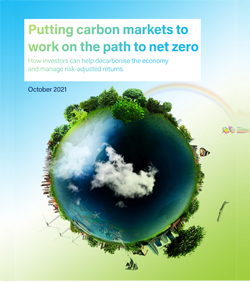GIC, the Singapore Economic Development Board (EDB), and McKinsey & Company on Friday (Oct 29) published a joint report, Putting carbon markets to work on the path to net zero: How investors can help decarbonise the economy and manage risk-adjusted returns. The research outlines how institutional investors can play a critical role in helping to develop viable carbon markets in their pursuit of global climate goals, whilst also fulfilling their own mandates.
According to the analysis, carbon markets are rapidly approaching critical mass from an institutional investment perspective.
Compliance carbon markets (CCMs)* have matured over time, with a global market value of over US$100 billion, and are becoming easier for investors to understand. Voluntary carbon markets (VCMs), on the other hand, are much smaller at US$300 million in value, making them largely unviable for institutional investment today.
With more standardised and transparent pricing, and more established governance mechanisms, however, VCMs could outpace CCMs to bring them to a similar total global market value as soon as 2030.
“Well-governed, liquid and scalable carbon markets could play a significant role in meeting global climate goals. Carbon markets must, however, not divert efforts from cutting carbon emissions at source, and should contribute to the overarching goal of a low carbon future. Our paper found that with greater scale and more robust governance standards, carbon markets could offer investors an effective tool to manage climate-related risks, and to support portfolio companies in their transition journeys”, said Liew Tzu Mi, Chief Investment Officer for Fixed Income, and Chair of the Sustainability Committee at GIC.
One in five of the world’s 2,000 largest publicly listed companies have now committed to a net zero emissions target, along with countries responsible for 61 percent of global GHG emissions. To achieve these targets, companies must work towards decarbonising their own operations and value chains, while compensating for and neutralising their existing and residual emissions through high-quality carbon credits.
Institutional investors also have an interest in driving decarbonisation efforts, since their portfolios are being exposed to increasing levels of climate risks.
Working with Vivid Economics, McKinsey’s strategic economics consultancy, and its climate analytics suite, Planetrics, the researchers conducted bottom-up modelling of the relative impact of climate risks across individual asset classes. They found that, in scenarios assuming immediate or even delayed climate action, carbon allowances could improve the risk-adjusted returns of a 60/40 reference portfolio†. On average, an allocation of approximately 0.5 to 1 percent was sufficient for portfolio risk diversification under climate transition scenarios. The only scenario in which carbon allowances led to decreased returns was one where no new climate change policies were introduced.
While the reasons for institutional investors to consider active participation in carbon markets are compelling, they also need to be mindful of their role in providing useful services such as liquidity, price discovery and matching supply and demand, and to refrain from speculative trading.



